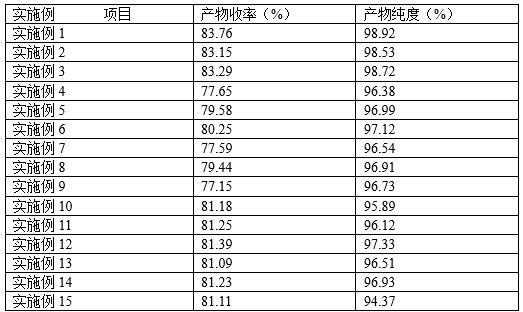Synthesis method of 2,2,2',4',5'-pentachloroacetophenone
A technology of pentachloroacetophenone and synthetic methods, applied in two fields, can solve problems such as high usage of Lewis acid catalysts, excessive reaction residues, low product purity, etc., to avoid reaction rate, reaction degree, reaction The effect of thoroughness and purity improvement
- Summary
- Abstract
- Description
- Claims
- Application Information
AI Technical Summary
Problems solved by technology
Method used
Image
Examples
Embodiment 1
[0023] A method for synthesizing 2,2,2',4',5'-pentachloroacetophenone. The raw materials include 63 parts of 1,2,4 trichlorobenzene, 51 parts of dichloroacetyl chloride, and 45 parts of catalyst in parts by weight. parts, 39 parts of water; the specific method is:
[0024] (1) Put the above-mentioned 1,2,4-trichlorobenzene and 30% of the above-mentioned catalyst by weight in a reaction tank and stir and mix at a stirring rate of 140rpm, keep the temperature at 50°C for 45min, and then add 60% of the catalyst dropwise in 55min For the above weight part of dichloroacetyl chloride, keep the stirring speed constant, add 40% of the above weight part of the catalyst, dropwise add the remaining weight part of dichloroacetyl chloride within 35min, raise the temperature to 70°C, keep the temperature for 1.5h, and then add the remaining weight part catalyst, heat up to 90°C, adjust the stirring speed to 380rpm, and raise the pressure of the reaction tank to 6.5×10 5 Pa, keep the reacti...
Embodiment 2
[0032] A method for synthesizing 2,2,2',4',5'-pentachloroacetophenone. The raw materials include 52 parts of 1,2,4 trichlorobenzene, 40 parts of dichloroacetyl chloride, and 58 parts of catalyst in parts by weight. part, 50 parts of water; the specific method is:
[0033] (1) Put the above-mentioned 1,2,4-trichlorobenzene and 30% of the above-mentioned catalyst by weight in a reaction tank and stir and mix at a stirring rate of 80 rpm, keep the temperature at 40°C for 55 minutes, and then add 60% of the catalyst dropwise within 60 minutes For the above weight part of dichloroacetyl chloride, keep the stirring rate constant, add 40% of the above weight part of the catalyst, dropwise add the remaining weight part of dichloroacetyl chloride within 30min, raise the temperature to 65°C, keep the temperature for 2h, and then add the remaining weight part catalyst, the temperature was raised to 95°C, the stirring speed was adjusted to 300rpm, and the pressure of the reaction tank was...
Embodiment 3
[0041] A method for synthesizing 2,2,2',4',5'-pentachloroacetophenone. The raw materials include 5 parts of 1,2,4 trichlorobenzene, 62 parts of dichloroacetyl chloride and 32 parts of catalyst in parts by weight. parts, 28 parts of water; the specific method is:
[0042] (1) Put the above-mentioned 1,2,4-trichlorobenzene and 30% of the above-mentioned catalyst by weight in a reaction tank and stir and mix them at a stirring rate of 200rpm, keep the temperature at 60°C for 35min, then add 60% of the catalyst dropwise within 50min For the above weight parts of dichloroacetyl chloride, keep the stirring rate constant, add 40% of the above weight parts of the catalyst, dropwise add the remaining weight parts of dichloroacetyl chloride within 40 minutes, raise the temperature to 75 ° C, keep it warm for 1 hour, and then add the remaining weight parts The catalyst is heated up to 85°C, the stirring speed is adjusted to 450rpm, and the pressure of the reaction tank is raised to 7×10 ...
PUM
 Login to View More
Login to View More Abstract
Description
Claims
Application Information
 Login to View More
Login to View More - R&D
- Intellectual Property
- Life Sciences
- Materials
- Tech Scout
- Unparalleled Data Quality
- Higher Quality Content
- 60% Fewer Hallucinations
Browse by: Latest US Patents, China's latest patents, Technical Efficacy Thesaurus, Application Domain, Technology Topic, Popular Technical Reports.
© 2025 PatSnap. All rights reserved.Legal|Privacy policy|Modern Slavery Act Transparency Statement|Sitemap|About US| Contact US: help@patsnap.com

